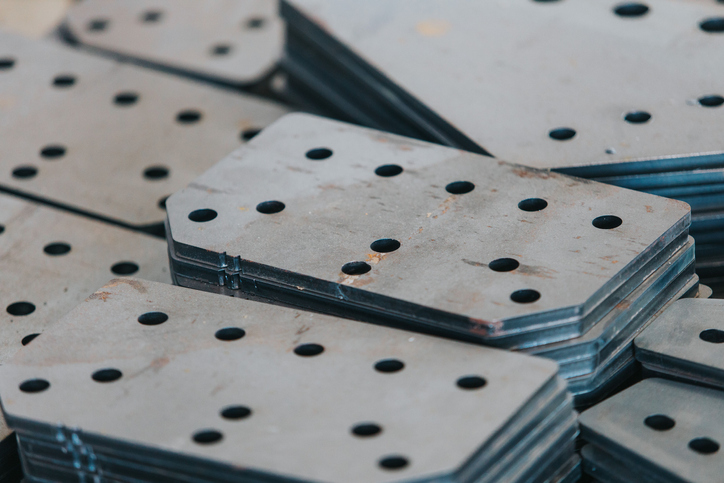The term “quenching” is a heat treatment process for ferrous materials that improves their physical and mechanical properties by altering their crystalline structure. It involves heating the ferrous workpiece to a high temperature, then quickly cooling it. The quenching or cooling medium is typically oil or water. However, the Salt Quenching process uses various mixtures of salt bath mediums like NaNO2 or KNO3 for the quenching.
This article delves into the salt quenching process, reviews alternative quenching techniques, and compares salt, oil, and water quenching methods.

What is Salt Quenching?
The purpose of the salt quenching process is to obtain maximum strength & ductility through uniform heat transfer. It involves heating ferrous materials at a specific temperature and immersing them in a salt bath for quenching. Meanwhile, the salt bath is made with mixtures of different salts in different proportions according to the composition of the workpiece and required properties. Consequently, the heating temperature of the bath also varies on blend composition. However, the temperature range for most salt quenching operations is generally between 300-1000°F.
Salt quenching does heat extraction mostly by convection. The uniform heat transfer from metal to the surrounding salt solution and the low cooling rate reduces defects like surface distortion & cracking.
The Process of Salt Quenching: Step-by-Step
Producing desirable heat treatment outcomes happens by carefully handling each step of the salt quenching process.
Workpiece Preparation
The first step is to prepare the workpiece for the treatment process. It includes cleaning the surface to remove burrs, oil, debris, or other contaminations. Often, the use of acid cleansing is necessary if the workpiece surface contains rust or heavy dirt. This cleaning process ensures uniform heating and limits the possibility of chemical intervention due to contamination.

Ceramic Salt Bath Furnace
Courtesy: Upton
Salt Bath Preparation
Next, the mixture of salt solution is heated in the furnace at a predetermined temperature. The right mixing ratio and bath temperature are critical for the cooling rate and final properties. Meanwhile, the furnace for bath preparation contains either a gas-fired system or electrodes as the heating mechanism. In addition, the furnace might contain an air/water heat exchanger system to control the temperature during the quenching process.
Heating the Workpiece
The cleaned workpiece is heated in a furnace to a specific temperature for a specific time based on the material type. For example, the heating of steel or iron alloys is typically between 800 °C and 1,200 °C. The extensive heat changes the microstructure of the ferrous workpiece from ferrite to austenite.
Immersing into Salt Bath and Quenching
Sometimes workpieces are directly heated in the salt bath, otherwise, they are separately heated before immersing into the salt bath. On immersion, the salt extracts heat from the metal until it attains room temperature and locks the altered microstructure.
Washing of Salt
Finally, the residual salt is washed away from the final parts using water or other solvents. Ensuring no salt remains on the surface helps to prevent the risk of corrosion or other damage.
Alternative Quenching Methods
Besides salt quenching, there are other quenching methods applicable in the heat treatment & hardening projects. The most common are water quenching and oil quenching.
Water Quenching Method
The water quenching process utilizes pure water or salt water to quench components after heat treatment. It entails immersing metal components directly into water at room temperature (15 to 25°C) right after heating to a set temperature. Moreover heating requirements vary according to the type of metal or alloy. For instance, it is 845 to 870°C for steels.
The water quenching process is quick and it can achieve a high level of hardness, especially for the low carbon steels. However, this quick cooling rate poses a risk of inducing stress in the components.
Oil Quenching Method
Using oils to stabilize the martensite transformation of heated ferrous parts balances the stiffness and brittleness with increase in hardness. Thus, this method does not make the part too brittle like in water quenching.
The common oils used for quenching are Shell Voluta C, Durixol VNA 15, and canola oil. The choice of oil type and temperature of the oil solution directly impacts the final properties. Some oils quench the metals at room temperature, whereas some require elevation to higher temperatures (50 to 100°C).
Salt Quenching vs Oil and Water Quenching
Although all quenching methods increase the hardness and strength, the intensity of increment and change in other properties (like stiffness and brittleness) are distinct for each one. Furthermore, there are differences in Salt vs. Oil vs. Water Quenching in terms of cooling rate, complication, application suitability, etc.
| Aspect | Salt Quenching | Oil Quenching | Water Quenching |
| Hardening Type | Martensitic with controlled fractions of bainite. | Mostly martensitic with very little bainite | Predominantly martensitic |
| Suitable Metals & Alloys | High carbon steels like AISI 1045 and 1080, tool steels, and light metals. | Alloy steels and tool steels | Low-carbon steels and cast iron |
| Quenching Temperature | Higher than oil and water (150°C – 500°C). | Typically 50°C – 100°C (or can be room temperature, based on oil type) | Room temperature |
| Heat Transfer Rate | Moderate to high. | Low to moderate | High |
| Quenching Speed | Moderate to fast. | Slow to moderate | Very fast |
| Quenching Cost | High due to the cost of salts and maintenance. | Moderate, depending on the oil type. | Highly cost-effective |
| Application examples | Aluminum aerospace parts, cutting tools, titanium-made implants, etc. | Gears, shafts, forging dies, stamping tools, etc. | Tools, knives, blades, springs, etc. |


